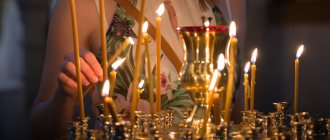About kissing the deceased
Come, let us give our last kiss, brothers, to the deceased, praising Christ. Having come from birth and approaching the grave, I no longer care about the vanity of the multi-passionate flesh. Where family and friends are now, behold, we are separated. Let us pray to the Lord for his repose,” the song sounds.
This and subsequent stichera of the last kiss sound like a conversation between the deceased and the living.
- Now, brother, are you coming to us, why are you leaving us in silence?...
“I go to the Lord God my judge, I will appear before the judge...”
These words, causing tears of tenderness, however, do not plunge us into despondency and do not increase sadness, but, on the contrary, kindle in people a fervent prayerful feeling that has almost died out in the bustle of life. For many modern Orthodox Christians, turning to God began from the moment of burial of loved ones, because a well-executed prayer for the dead enlightens even hardened souls.
The very sequence of saying goodbye to the deceased during the rite of church burial is also touching. The last minutes when on this earth we see the face of a person dear to us. For the last time we ask him for forgiveness for our sins against him. We forgive him and bless him in the name of God on his last journey.
In different places, the last kiss has its own characteristics. For example, in Moscow a lectern with the Holy Cross is placed in front of the coffin. When singing the stichera, first the priest and the deacon, then the relatives of the deceased and all those praying ceremoniously approach the Cross on the left side of the coffin: the women follow the men, two in a row. Having made two bows to the waist, they alternately kiss the Cross and make one more bow to the ground. After kissing the Cross, they approach the coffin one at a time, on the right side, and kiss the deceased. In other localities, the lectern is placed on the right side of the coffin and the icon of the Most Holy Theotokos with the Eternal Child is placed on it, and not the Cross. Those present come up in pairs from the right and with the same bows kiss the image of the Savior on the right leg, and the image of the Virgin Mary on the right hand, and then kiss the deceased. Various kisses of the deceased himself are also known. In some areas they kiss on the mouth, in others - on the corolla lying on the forehead.
All these features are not indicated in liturgical books, but have been passed down from ancient times from generation to generation. Here you just need to observe the order and uniformity accepted in this place.
Like other funeral rites, kissing also has a theological meaning. Saint Simeon calls it a sign of communication and unity, a sign of the fact that “even when we die, we are not separated from each other... because we will live in Christ.”
O. Mikhail Maslyaev at the coffin of a parishioner. Voronok, 1936
A few words should be said about the burial of monks: when lay people are present at the burial of a monk, they should not kiss him, but simply bow to the ground in front of the coffin. Only monks kiss the deceased monk - on the paramand (a quadrangular plate with the image of the Crucifixion), which covers the face of the deceased. Likewise, a monk at the funeral of a layman does not kiss him, but simply bows.
Everyone must bow to the ground of the deceased, regardless of church or secular rank. At the same time, one must mentally ask for forgiveness from the deceased, forgiving him of all his sins.
Bowing three times to the deceased and saying goodbye to him, everyone quietly, “to himself” says:
- Servant of God (or: servant of God), (name of the deceased), forgive me for Christ’s sake in everything and for everything;
- And God will forgive and bless you;
- If you have courage, pray for me, a sinner, to the Lord God.
How the funeral service is conducted
The funeral service consists of chants that reflect a person’s earthly path. For breaking the commandment of the Lord, a person is expelled from paradise and returns to the land from which he was taken. Nevertheless, man remains the image and likeness of the Creator, therefore the Church prays to forgive man his sins and accept him into the Kingdom of Heaven. The Holy Church prays for the departed, giving them hope for posthumous forgiveness of sins.
To perform a funeral service you need:
- know the will of the deceased himself (often people on their deathbed ask that their soul be sung by a certain priest in a particular church or they ask not to have a funeral service for them, in which case the question of a person’s free will comes to the fore. The Church does not perform a funeral service for those who themselves did not want it) ;
- make sure that the deceased was baptized;
About the farewell certificate
After the end of the kissing, the priest, having read the prayer of permission written on the sheet above the coffin, writes in it the name of the deceased and his own, then places the folded sheet in the right hand of the deceased. This custom is very ancient, it is widespread only on Russian soil. In ancient times, a certain warrior Simon was the first to ask the Monk Theodosius of Pechersk (c. 1008 - May 3, 1074) after his death to place such a travel document in his hand, which the reverend did.
Rev. Theodosius of Pechersk with his life (17th century icon)
The Venerable Nestor the Chronicler (c. 1056 - 1114) remarks on this matter: “before this, do not create calico things in Rus'.” The deceased subsequently appeared in a vision to one of the monks of the Pechersk Monastery and said: “Tell my son that I received everything good through the prayer of the saint.” prince Alexander Nevsky (May 13, 1221 - November 14, 1263) is also widely known
St. Alexander Nevsky. Fresco, 1666, Moscow, Kremlin, Archangel Cathedral, painting of the south-eastern pillar
Unfortunately, along with this pious custom, we often encounter a superstitious attitude towards farewell letters. Some Christians, by various means, strive to obtain a handwriting from their confessor during their lifetime - as if “just in case.” This is completely incorrect, since in the prayer of permission written in the letter, the priest, in the name of God, forgives his deceased spiritual son (daughter) for all sins for which the deceased was bound by penance during his lifetime or which he did not have time to confess due to oblivion or other excusable reasons. And to “allow” for those sins that a person has not yet committed for the future is meaningless and illegal.
A farewell letter in itself cannot save a person’s soul. A person is saved by right faith, good deeds and pure repentance of sins. What saves are the prayers of the holy saints of God, those who have been honored to offer prayers to God for those now living on earth, the prayers of priests and monks, as well as brothers in faith. The prayers of a spiritual father have great power before the throne of God.
A farewell letter is also called a handwriting
From the Life of St. Basil the New (d. ca. 944) we learn how the soul of the deceased Theodora, which the Angels carry to the throne of God, with great fear meets on its way “air tax collectors” - demons who convict the soul of many grave sins and seeking to snatch her from the hands of the Angels. Angels protect Theodora's soul from demonic slander, speaking about the good deeds of the deceased, her repentance and prayers. And when her good deeds are not enough to justify her, they, as if from some casket, give the demons a ransom, having received which the tax collectors immediately retreat. This ransom is the prayers of St. Basil, Theodora’s spiritual father. Of course, prayer is a spiritual matter, and the casket in the Life is spoken of figuratively so that we can imagine things that are inaccessible to sensory perception.
Likewise, handwriting is a visible image of prayers and forgiveness from the spiritual father. It serves to ensure that we, the living, strive for repentance. If the conscience of the deceased is burdened with great unrepentant sins and he never prayed to God: “Turn away Your face from my sins, and cleanse all my iniquities” (Ps. 50:10), then will this letter benefit him?
Funeral service for the deceased in the Western Dvina: order and rules
When a person’s soul leaves for another world, it is difficult for loved ones, even if they are members of the Church, to survive the loss. Funeral service for the deceased... At such moments, you want to do something for the deceased, help him go through the difficult path of ordeal and meet the Lord. Can this be done if the person is already dead? In the Gospel of Luke we find words of consolation: “God is not God […]
When a person’s soul leaves for another world, it is difficult for loved ones, even if they are members of the Church, to survive the loss. At such moments, you want to do something for the deceased, help him go through the difficult path of ordeal and meet the Lord. Can this be done if the person is already dead?
About the libation of oil
After the priest places a farewell letter into the hand of the deceased, the singers sing the stichera:
You see me speechless and without breath, all your brothers and friends, relatives and friends, weep for me. For yesterday the words were with you, but suddenly the terrible hour of death came to us. But come, all you who love me, and kiss me with your last kiss. I won’t come to you and talk to you anymore. But the rest is coming to the Judge, where there is no face to accept. A slave or a ruler stands together, a king and a warrior, a rich man and a poor man, of equal rank. Each one will either become famous or condemned by his own deeds. But I pray all the time and fall down, pray for me to the Lord, so that I will not be brought by my sin to a place of torment, but may He punish me, where there is the light of life.
These words are very significant - everyone will either be glorified or condemned by their own deeds; we must always remember them. And our main covenant at the hour of departure from earthly life will be a request to all Christians to continually pray for us.
If the priest accompanies the body to the grave, then this stichera must be sung already at the cemetery or approaching it. But where this is not possible, the burial is served until the end in the church. This method became widespread during times of persecution, when Old Believer priests could not perform any services outside the church walls. Also, the following ritual is often performed inside the temple - the pouring of oil.
St. Dionysius the Areopagite. Fragment of a fresco. Veliky Novgorod, Theophanes the Greek Having placed a sheet with a prayer of permission into the hand of the deceased, the priest breaks the thread that gathers the head of the shroud and lowers it onto the face of the deceased. He also removes the cover from the coffin, and the linen folded under it in half is straightened, covering the body from head to toe. Now the priest, standing to the right of the deceased, pours oil on him in a cross shape, starting from the head. Blessed Simeon of Thessalonica advises taking oil from the altar; some priests take it from the lamps of the seventh candlestick. If the burial takes place in a chapel or in a house, and oil from the altar is not stored in advance, then you can take it from any lamp. If the deceased received unction before death, then during the burial the priest pours the remaining oil from the unction on him.
Oil is poured over all the deceased, regardless of whether they were unctioned or not. Saint Dionysius the Areopagite explains this rite as follows: “At Baptism, anointing with oil called the baptized person to sacred deeds, and now the libation of oil indicates that the deceased has labored in these deeds and has achieved perfection.” The same meaning is contained in Psalm 23, which the priest must read:
Who will ascend to the mountain of the Lord, or who will stand in the place that sanctifies Him? He is innocent in his hand and pure in heart, who does not accept his soul in vain, and does not swear by his sincere flattery. This one will receive a blessing from the Lord...
Therefore, the psalm must be read aloud in its entirety, as indicated in the rites of monastic and priestly burial. The fact is that in the rite of secular burial in this place, for the sake of brevity, only the first words of the psalm are given, which is why many priests limit themselves to pronouncing them.
Is it possible to have a funeral service in the morgue?
If there is a chapel at the morgue that belongs to the Russian Orthodox Church, then the person’s funeral service can be performed there. Funeral service for the deceased... Unfortunately, it often happens that at a person’s morgue the funeral service is performed by a priest who does not have canonical status. Before the funeral service, it is better to clarify whether the chapel at the morgue belongs to a particular diocese of the Church.
The funeral service usually follows a certain canon.
- After reading the Initial Prayers, the burial of the layman begins with Psalm 90: “He who lives in help will dwell in the blood of the heavenly God...”.
- After it, the entire 17th kathisma is read or sung: “Blessed art thou, O Lord, teach me by Thy justification...” with choruses. Psalm 119 is divided into three articles (parts), for each verse of the first article the refrain: “Alleluia”, for each verse of the second article the refrain: “Have mercy on Thy servant (or Thy handmaid)”, for each verse of the third article the refrain: “Alleluia”, between the articles, the priest pronounces a funeral litany (“Have mercy on us. God, according to the greatness of Your mercy...”). When singing Immaculate, those present at the funeral service stand with lit candles.
About committing to the earth
When the priest was not able to accompany the coffin to the grave, the “commitment to the earth” was symbolically performed inside the temple. In this case, the priest sprinkles a small amount of dry earth or sand not on the closed coffin, but on the body lying in the coffin, covered with linen, just as he pours oil. At the same time he says:
All from the earth, and all into the earth, O Lord, You send the soul of Your servant, who will receive peace with the saints.
That is: “Everything taken from the earth, that is, everything corruptible, mortal, you send to the earth, Lord. And rest the immortal soul that You took with the saints.”
For centuries, our people have not translated the opinion, coming from paganism, that the main thing in a church burial is precisely “tradition of the deceased to the earth.” Many people believe that the earth does not accept the uninveterate dead man, and they are afraid that he will frighten his relatives in dreams or in reality. All this is superstition. Often people, by hook or by crook, achieve church burial even for people for whom it is clearly illegal and blasphemous. Having been refused by their Church, they perform the funeral service for the deceased with the New Believers, explaining that “there is no other way out.” In such cases, this is no longer a concern for the soul of the deceased, but a desire to perform the ritual of “traveling him to the earth.” But the very words proclaimed by the priest clearly say that the earth accepts all the sons of Adam - righteous and sinners, faithful and unfaithful.
That’s why it is said: “you send everything to the ground.” And the priest prays not for that which is accomplished from eternity by nature, but for the repose of the soul of the deceased with the saints. And this is exactly what superstitious people don’t care about. They did not call their brother to repentance during his life, and now that he has died and is going to the Judge, “where no face is accepted,” they do not want to weep for his soul before God, doing fasting and alms, but strive only to thoughtlessly fulfill a ritual whose meaning they themselves do not understand.
“You are earth, and you will go back to earth,” the Lord said to Adam after his fall. These words expressed the forefather's rejection of original honor and glory. But in Christ we, the descendants of Adam, are called from corruption to incorruption, to eternal glory: “from death to life, and from earth to heaven Christ has brought us God…” (Easter Canon, Canto I).
The goal of a believer’s life is to be worthy of an eternal kingdom with Christ after His glorious Second Coming. So is it really possible that, having such great promises, we will strive not for a bright life, but for a dark land, for oblivion and darkness?
If “tradition to the earth” takes place in a temple, then after it the relatives should no longer reveal the face of the deceased. However, if due to some unforeseen circumstances this did happen, then there is no need to panic. Some ignorant people believe that if, after sprinkling with earth, the face of the deceased is revealed, he should be buried again. But this is only a superstitious idea, since the purpose of church burial is not so much to bury the body as to repose the immortal soul.
Funeral service in Western Dvina. Call
In the Gospel of Luke we find words of consolation: “God is not the God of the dead, but of the living. For with Him all are alive.”
God created us for heavenly bliss and immortality, but man rejected the priceless gift of the Lord. The Fall that Adam and Eve committed doomed all of humanity to decay and death. The Holy Apostle Paul said that along with sin, death entered the world. A person is stricken with death, like a disease. But the Lord is merciful. To save humanity, He sent His Only Begotten Son into the world - our Lord Jesus Christ. Having endured suffering and death for the sins of mankind, the Savior entered into a new union of man with God, opening the path to Heaven for us through the symbol of victory over death - the Cross of the Lord.
We have hope for eternal life with God, and death for the Orthodox is only the beginning of a new path. “For me to live is Christ, and to die is gain,” said the Apostle Paul.
About carrying the coffin to the grave
The coffin is taken out immediately after the end of the kissing. Another custom is also known - to carry out the troparions “With the Spirits of the Righteous” during the singing or after them. This is what they did at the Rogozhskoye cemetery in Moscow. Or the dismissal and initial bows are performed in the church and the coffin is escorted to the burial place with the singing of only the prayer “Holy God.” If possible, one should strive to fulfill the order in everything according to the Consumer Order, as it has developed over the centuries, accompanying every funeral action with deeply instructive and touching prayer.
It is customary to carry the Holy Cross or icon in front of the coffin. In some places, as evidenced by the “History of the Vetkovo Church,” consecrated kutia is also worn in a row with the icon in order to taste it after burial.
It is known that in different localities it is customary to wear the coffin lid differently - either in front of the coffin, directly behind the icon, or vice versa, at the back of the entire funeral procession. Of course, in ancient times, when the lid and coffin were made from a log cut in half and were not decorated in any way, it made no sense to carry it in front. But now that the Holy Cross is sewn onto the lid of the coffin, the custom of wearing it in front of the coffin seems quite understandable. Although, in order to avoid temptation, preference should be given to the custom established in the given area.
According to a long-standing tradition, three stops are made along the way: in the courtyard of the temple, in the middle of the path and at the cemetery itself. In this case, the coffin is placed on prepared stools; The icon, which is carried at the head of the procession, is turned to face the mourners. The priest with the censer proclaims a special litany, once again calling for prayer for “peace and forgiveness” of the sins of the deceased. After his exclamation “For you are the resurrection...” they sing “Amen”, the coffin is lifted and carried further with the singing of the “Trisagion”.
At the grave, the priest pours oil on the deceased, and after that, when the coffin is already closed with a lid, having said absolution, he reads a prayer of permission. Then the closed coffin is lowered into the grave, and the priest, taking a shovel, sprinkles it with earth in a cross shape, with the words:
You send everything from the earth, and everything into the earth, O Lord...
There is an unwritten local custom - to sing a litiya over the coffin of the deceased before committing him to the earth or after that. This custom probably reflected the combination of funerals with the commemoration of the third day. So, performing lithium at the end of the burial on the third day (tretina) does not seem superfluous, but even commendable.
In any case, after the burial, the mourners read the troparion “ O Lord, rest the soul of His departed servant... ” with 15 bows. Then, having made the so-called “initial beginning” (seven bows), people once again say goodbye to the deceased and disperse.
Previously, the return of the funeral procession was decorous, soulful and comforting. The icon was carried in front, people continued to walk along with drawn-out singing, for example:
Give consolation to Your servant, O All-Immaculate One, quenching the cruel circumstances that befall us. For You alone are firmly established and the foundation of the Imam is known, and Your intercession as a money-grubber; Let us not be ashamed, O Lady, calling upon You, striving for the prayer of those who cry out to You: Rejoice, Lady, helper of all, joy and protection for our souls (verse 4 tones).
Seeing off the body
When carrying the body of a priest to the church and to the grave, they usually carry banners, a cross and the Gospel in front of the coffin, and there is a funeral bell ringing, since this procession is a procession of the cross. At every temple that the procession passes, there is a ringing sound; the coffin stops in front of the temple and a funeral litia is performed (See Guide to the study of the law. Theology. Nikolsk. 749 pages. Trustee of the right. church. Debolsk. 395 pages).
In addition to the litia, when carrying the body of a deceased priest, the irmos of the canon Helper and Patron are sung (Great Treb. and New Skr.
XXII §6).
In church, during the funeral service for priests, their coffins are placed closer to the pulpit than the coffins of the laity, and four candlesticks must be placed around the coffin on four sides
(Ibid.).
The body of a deceased priest must be carried by priests, if there are a sufficient number of them (See the requirement in the last death over a deceased priest).
About the arrangement of the grave
The Holy Fathers teach us not to arrange expensive tombstones, but call us to “send the property of the deceased to heaven” in the form of alms. The grave and tombstone of a Christian should be arranged simply and modestly.
Graves of Old Believers at the Rogozhskoye cemetery in Moscow
We believe that on the day of the general resurrection the dead will come to life and will find their bodies in a new quality, not subject to decay and destruction. And people who were burned, and drowned, and torn apart by beasts will appear before God’s court, without any external harm, but only one seal of their lifetime deeds. The righteous will have faces bright and full of joy, while the evil and wicked will have faces blackened with shame and horror. But, believing in the resurrection of the flesh, Christians, however, shun the pagan custom of burning corpses, which is widespread in our time, which has a clear image of fiery hell.
Christian burial, in all its rites, expresses what we believe and what we expect after death. The deceased is placed facing east, as a sign of his faith in the Resurrection of Christ and in anticipation of the general rising of the dead. And above the grave, “at the feet” of the deceased, is placed the Honest and Life-Giving Cross of our Lord Jesus Christ.
Previously, in Russia crosses were most often made from strong wood, the size of an average person. The image of the Cross was also carved on stone tombstones. But now Old Believer cemeteries, just like all others, are replete with iron crosses or monuments. And some are also “decorated” with all sorts of iron patterns, like Nikonian ones. Also in the Old Believers, it became common to cover the grave with tiles and erect a high fence. The relatives of the deceased seem to be trying to wall up their relative. But, speaking with regret about this, let us recall the words of St. Athanasius the Great: “Even if the deceased is laid in piety under the open sky, do not deny, calling on Christ God, to light oil and candles on the tomb: this is pleasing to God and will merit great reward from Him.” . With this in mind, to perform funeral prayers in the cemetery, it is better to always have with you an icon or Cross depicting the Crucifixion of the Lord.
On what day after death is the funeral service held?
The burial of a person takes place on the third day after death. The funeral service according to Orthodox custom is also performed on the third day from the moment of death.
The first day is considered to be the day of death itself (that is, if a person died on Wednesday, then it is customary to bury him on Friday).
According to a special rite, the funeral service is performed on the days of Bright Easter Week: instead of sad funeral prayers, joyful solemn chants of Holy Easter are sung.
On the day of the Holy Resurrection of Christ and on the Feast of the Nativity of Christ, the deceased are not brought into the church and funeral services are not performed, moving it to the next day.
The difference between a funeral service and an “ordinary” prayer for the deceased
Prayer for the departed carries the same mission as the funeral service, but in the case of the funeral service, the entire Church prays for the soul of a person, giving people hope for posthumous forgiveness of sins. Special days of remembrance are the third, ninth and fortieth days after the death of a person. On the third day, remembering the resurrection of Christ, the Church asks the Lord to resurrect a person for eternal life. On the ninth day, the Church asks for the deceased to be canonized among the saints of God. Funeral service for the deceased... On the fortieth day, a prayer is made that Jesus, having ascended to Heaven, will ascend into the Kingdom of Heaven. At the request of relatives, a person can be remembered in prayer for forty days after his death. This commemoration is called forty-one.
Does a funeral service provide a “guarantee of entry” into heaven?
A funeral service does not guarantee that a person will certainly go to heaven. There can be no guarantees in faith, but this is exactly what can be done on earth for a person who has already gone to another world. And hope for God’s mercy does not fade away with the death of a person.
The living can continue to pray for the deceased after the funeral service. The funeral meal brings together everyone who knew and loved the person at the table in joint prayer. One of the main dishes of the funeral table is kutia made from wheat or rice grains. Like grain, man is placed in the ground and decays in order to be born again to eternal life. Honey and sweets in kutya symbolize the sweetness of heavenly bliss.
Who can't have a funeral service
The Russian Orthodox Church does not perform funeral services for:
- unbaptized (if people themselves did not want to become members of the Church during their lifetime, you can always pray for them privately);
- Gentiles;
- God-fighters;
- those who renounced Christ;
- suicides (the exception is taking one’s own life during a mental illness, but this must be proven and permission to perform a funeral service obtained from the ruling bishop);
- Until recently, funeral services were not performed for unbaptized infants, but recently a special rite was prepared.










